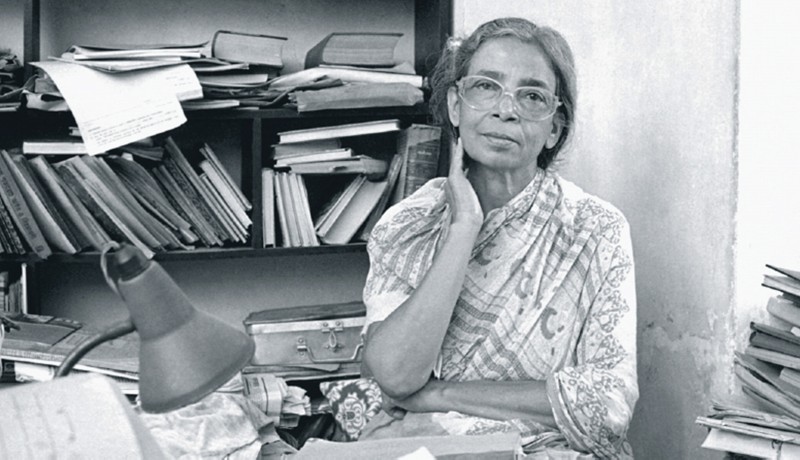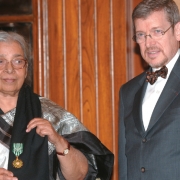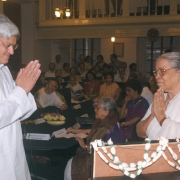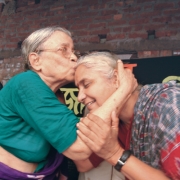
People

Mahasweta Devi has consistently used her writing and activism to plead the case of the marginalised. Harmony discovers how anger at their plight and hope for a better tomorrow keep her going
I find my people still groaning under hunger, landlessness, indebtedness, and bonded labour. An anger… directed against a system that has failed to liberate my people from these horrible constraints, is the only source of inspiration in all my writing. All the parties to the Left as well as those to the Right have failed to keep their commitment to the common people. I do not hope to see in my lifetime any reason to change this conviction… Hence I go on writing to the best of my abilities about the people, so that I can face myself without… guilt or shame. For a writer faces judgement in his lifetime and remains answerable.
— Mahasweta Devi in her introduction to Agnigarbha (1978)
It’s not easy to get a conversation going with Mahasweta Devi. People walk in and out of her small first-floor rented flat in South Kolkata’s Golf Green with their problems — a job needed, admission into a hospital, help with civic authorities… the list is endless. Her phone rings incessantly. And it’s clear she doesn’t see the point of a rerun of her life as writer-activist-journalist. “Why do I need to give an interview?” she rasps, dressed in her cotton housecoat, silver strands combed back into a bun. “My work should speak for itself.”
The 82 year-old answers her phone with the same brusqueness, numbing some callers into silence with monosyllabic responses. Others, like a person calling for help to write an application or a member of a tribal group, get more time — here, she listens patiently, taking notes or referring them to the right person.
There are no clues to her literary stature in this flat, rented for Rs 6,000 per month, no signs that it’s the home of an award-winning writer who has written over 20 short story collections and 100 novels; the last two, Jarotkumari and Pancha Kanya, as recently as 2006. In her sparse room, her bed, a cluttered desk and lamp complete the décor; a talcum powder box, perched on a shelf, the only concession to vanity.
You finally get her attention only when you point to the newspapers scattered on the bed opened to reports on the Nandigram controversy — land acquisition for the chemical hub to be set up by Indonesia’s Salim Group in this rural area in the Purba Medinipur district of West Bengal, about 150 km from Kolkata, became a bloody affair earlier this year, putting the state government on the defensive. Villagers began fierce protests against the project. On 14 March, policemen entered Nandigram and fired at them, leading to 14 deaths. “Rich fertile land is being taken over forcefully by the government,” says Mahasweta Devi. “Activists like Mamata [Banerjee] and Medha [Patkar] were already involved; I have just butted in.”
Her “butting in” has led to regular visits to Nandigram, neighbouring Haripur, and Singur (where another bitter row over land acquisition for a Tata Motors plant is taking place), and participation in protest rallies. She began to write a regular column in Dainik Statesman on the issue, and has helped organise a rehabilitation camp and ‘health centre’ for the victims, for which she has donated Rs 200,000. She is also collecting used cycles to distribute in Nandigram — a poster above her desk screams, “Leave your old bicycles here”.
“This is the first time when faceless farmers are standing up to be counted,” she says. “Land is as dear to them as their mother and they will not sell out under any coercion. This is not only about Nandigram or Singur. This is a global issue.” At a protest rally on 17 March at the Esplanade area in central Kolkata, Mahasweta Devi spoke forcefully, censuring the government and urging it to make reparations to victims at Nandigram. Today, the project’s future is in doubt, thanks in large part to her efforts.
“When I see her on TV attending rallies, I wonder how she overcomes her cramps and need to go to the bathroom frequently owing to diabetes,” wonders younger sister Soma Mukhopadhyay. “A recent pro-establishment rally carried a banner that read ‘Restrain Mahasweta Devi’. We took it as a compliment!” Mahasweta Devi is cagey when you ask her about her diabetes, only allowing that she needs to inject insulin twice a day. Last year, she fractured her left arm and leg after a fall. “Before that, I could walk for 14-15 km at a stretch; now I have slowed down,” she grumbles.
People who know her well wouldn’t agree. “Mahasweta Devi looks like everyone’s favourite grandma but she’s made of steel,” reveals Anjum Katyal, editor, translator and poet. As series editor of the Collected Works of Mahasweta Devi, published in 23 volumes by Seagull, she has worked closely with her. “I have seen people requesting her to attend a function or a seminar,” says Katyal. “Her response would be ‘I can’t spare time.’ But she’d help out people in trouble any time.”
So has the writer in her taken a backseat to the activist? “Writer, activist… these are all tags,” she harrumphs. “I was never an ‘armchair’ writer, even when I wrote my first book on the Rani of Jhansi.” Not satisfied with existing historical records on the queen who challenged the British, in 1954 she left her only son Nabarun (then six) with her first husband, late Bengali theatre writer and activist Bijon Bhattacharya, and set off to Jhansi and Gwalior to do her own research. The result: Jhansir Rani, published in 1956, earned her an instant reputation of a writer with sincerity. “I felt this was the best way to write — by visiting places and talking to people. And when you talk to people, you want to improve their lot if you can. That’s what people call ‘activism’ nowadays. To me, the process appears very logical. I am just me; I cannot be branded.”
Through her writing — fiction, essays and columns — she has concentrated on the marginalised, people pushed to the periphery by a ruthless power (the feudal system, legislation or the state). Horrors like rape, dispossession, exploitation, violence and murder are detailed in stark, unsentimental prose shorn of literary niceties and devices giving the reader the sensation of walking barefoot on scorched earth.
Despite her admittedly narrow focus (“I have no interest in the middle class”), her work has enjoyed popularity in India and overseas and been honoured with the Jnanpith in 1995, the Ramon Magsaysay Award in 1997 (“for her compassionate crusade through art and activism to claim for tribal people a just and honourable place in India”), and the Padmabhushan in 2006.
Her writings have been translated in many Indian languages, and in English, French, Japanese and Italian, and have been made into critically acclaimed films. Rudaali, a tale of a rural woman who is unable to weep despite the misery of her life, was adapted for the screen by Kalpana Lajmi in 1993. Hajar Churashir Maa (Mother of 1084), inspired by Kolkata’s Naxalite movement in the late 1960s and 1970s, was brought to life as Hazaar Chaurasi Ki Maa by Govind Nihalani in 1998. This story of the trauma of an upper-middle class woman who learns her son is lying dead in a police morgue owing to his involvement in the movement, became a cult classic. And in 2006, Chitra Palekar made her directorial debut (and Harmony’s Hotlist of achievers) with Maati Maay, her take on Baayen. Chandi, a Dalit gravekeeper accused of being a witch, is the protagonist of this dark tale about how a patriarchal society treats a woman who defies social norms.
Mahasweta Devi seems unmoved by all the praise for her writing. “I don’t like too much fuss about fame or awards,” she announces, drinking black tea unflappably from the saucer. This is a woman who barely tolerates anything that interferes with her urgency to depict a world rarely covered in literature; as she told Navin Kishore of Seagull in an interview, she “finds her own solitude in the chaos around to pour out her thoughts with lots of words”.
From the mid-1970s, her words have zeroed in on the plight of tribals in India through the years, who she calls “the suffering spectators of the India travelling towards the 21st century”. For instance, Aranyer Adhikar (Right of the Forest; 1977), which chronicles the life and struggles of tribal leader Birsa Munda in the late 19th century; Draupadi (1977), the tale of Dopdi, a rebel who refuses to be subjugated despite days of rape; and Iter Parey It (1987), about tribal women exploited at brick kilns.
Certain tribes in West Bengal — like the Lodha and Kheria (or Shabar tribes) and the Dhekaro — were branded criminal by the British under the 1871 Criminal Tribes Act as they were nomadic, travelling from village to village as minstrels or acrobats rather than pursuing fixed occupations. “Even a new-born baby in these tribes was branded a criminal by law,” says Mahasweta Devi. Although the Government of India ‘denotified’ these tribes in 1952, it made no provisions for their livelihood and they still suffer from the stigma of being ‘criminal’. “Age-old mindsets are difficult to change,” she rues. “Even today, they are treated like criminals in districts like Purulia, Medinipur, Birbhum and Bankura.”
She has travelled extensively in these districts, melding her life with the tribals’. “They trust me,” she says. Considering her background as student at Santiniketan and professor of English in Calcutta University, isn’t she a paradox to tribals who are so removed from her? “Who says they are different?” she snaps, chewing on tobacco. “You deny rights to these people, make them invisible, and then label them different! I live, eat and sleep with them like one of their family.”
It takes considerable prodding to get Mahasweta Devi to speak about her own family — her personal life has been marked by intense highs and lows. Upon her separation with Bhattacharya in 1961, she was also estranged from Nabarun, now a writer, for years. “I bled inside and even tried to commit suicide,” she said to Navin Kishore. She then married journalist Asit Tapas in 1965, only to divorce him in 1975. (She survives her former husbands.)
Although she says rather contrarily that she doesn’t stay “in continuous touch with her family as I don’t have that kind of time”, Tatagatha, her 32 year-old grandson, has forged a rapprochement between Mahasweta Devi and Nabarun, now 59. She also dotes on her great-grandson, three year-old Swayam, nicknamed Che after revolutionary Che Guevera. Her family lives in Golf Green too. “At times, we forget that she is a flesh-and-blood person too,” says Mukhopadhyay. “She’s a proud great-grandmother, she’s still on her feet and, in her own way, must be happy.”
Much of this happiness comes from her work. In 1980, she launched a Bengali quarterly, Bortika, which became a forum for marginalised people. And in 1983, she formed Paschim Bangla Kheria Sabar Kalyan Samiti, a welfare society to train tribals to earn their livelihood. “It is a self-sustaining unit now,” she declares, the barest hint of a smile on her face. “Also, when the Denotified and Nomadic Tribes Right Action Group was formed in Baroda in 1998 to fight for the protection of their human rights, it filled me with fresh zeal. The best part is that the right of the tribals over forest land has been recognised by the government.”
Mahasweta Devi still believes there’s much to be done and dismisses the sceptre of death with a wave of her hand. “Where’s the time?” she asks wryly, pointing to a calendar chock-a-block with engagements. Driven by anger and hope in equal parts, she soldiers on, driven by her belief that “the first right in the Indian constitution should be the right to dream”.
Now Dopdi spreads her arms, raises her face to the sky, turns towards the forest, and ululates with the force of her entire being. Once, twice, three times. At the third burst the birds in the trees at the outskirts of the forest awake and flap their wings. The echo of the call travels far.
— excerpt from Draupadi, by Mahasweta Devi
With inputs by Sulagana Biswas and Ruma Dasgupta
THE SISTER I KNOW
Soma Mukhopadhyay, 63, retired professor of Bengali from Calcutta University, shares her memories of her eldest sister…
We are a large family with five sisters and four brothers. Didi is the eldest, born when our mother Dharitri Devi was just 18. Our father Manish Ghatak was an income tax officer, but also a poet and writer. His youngest brother, who grew up to be filmmaker Ritwik Ghatak, was Didi‘s contemporary and friend. I am the eighth sibling, nearly two decades younger than Didi. My earliest memories of her are rather funny: she would be home from Santiniketan, and summon the young ones in the family and start cutting our nails, checking our hair for lice, cleaning our ears! She would insist we wore khadi. But she had a lighter side — she told us stories of Jim Corbett and took us to see Charlie Chaplin movies.
In college, she developed strong leftist leanings and did a lot of relief work during the Bengal famine. Once, when she was still in college, father bought her two silk saris. She refused to wear them. But I remember her in colourful cotton saris and big bindi, teaming them up with ‘Poona-style’ blouses with contrasting borders, sometimes putting flowers in her hair. But she was athletic too — a keen cyclist and swimmer. Her stamina, always strong, has stayed with her.
Despite her commitments as a writer and activist, Didi remains the ‘father figure’ of our family. She supported me financially during my MA and later, when I fell in love, she was a pillar of support. We have this family joke that Didi is our telephone directory for everything ranging from schools, hospitals and fire engines to psychiatrists! When my husband Ashok and I thought of writing a Bengali Thesaurus, she helped us tremendously with many rare books. Samartha Sabdakosh came out in 1987 and since then I have also edited four of her anthologies and hope to edit more.
We come together in the big and small moments of our lives — we call each other up everyday, sometimes even 10-12 times! We have lost five siblings, all our brothers and one sister, which makes us bond even more. She’s lost many comrades, and must be lonely. Her room has a photograph of our brother Maitreya: he was always by her side and she misses him sorely.
Featured in Harmony – Celebrate Age Magazine September 2007
you may also like to read
-
For the love of Sanskrit
During her 60s, if you had told Sushila A that she would be securing a doctorate in Sanskrit in the….
-
Style sensation
Meet Instagram star Moon Lin Cocking a snook at ageism, this nonagenarian Taiwanese woman is slaying street fashion like….
-
Beauty and her beast
Meet Instagram star Linda Rodin Most beauty and style influencers on Instagram hope to launch their beauty line someday…..
-
Cooking up a storm!
Meet Instagram star Shanthi Ramachandran In today’s web-fuelled world, you can now get recipes for your favourite dishes at….










